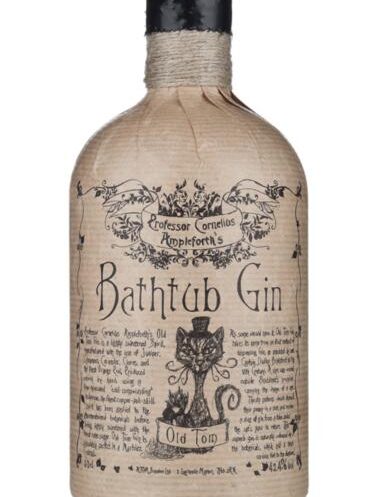That name Professor Cornelius Ampleforth’s Bathtub Old Tom Gin a mouth-full. But let’s break it down into some helpful definitions:
Bathtub Gin – owing to the fact that legally gin is simply “juniper flavored spirit,” one can make a gin by infusing/macerating, or alternatively “cold compounding” juniper berries and other botanicals in a spirit.
Old Tom Gin – the simplest, widely accepted definition for what an Old Tom Gin is simply a gin which has sweetening added after distillation*. Usually Old Tom gins feature a malty, character-filled base spirit which hasn’t been distilled to the point of being neutral, and often, but not necessarily by definition, have been rested in a barrel, usually for only as long as it needed to travel from distillery to pub.
Professor Cornelius Ampleforth – Master of Malt house brand based on a legend of a slightly mad Victorian re-creationist who hasn’t met a spirit of yore that he didn’t want to bring back. See Victor Frankenstein**
Tasting Notes
Cardamom, lemon and juniper on the nose of Professor Cornelius Ampleforth’s Bathtub Old Tom Gin, it comes across as sweet without being sweetened per se. The palate seems very true to what you had on the nose, with cardamom notes, a bit of pine-accented juniper, and some citrus, lemon chiefly, but notes of orange and even lime as well. Especially towards the finish, where the sweetness kicks in. It has a cloying, slight clover honey/slight simple syrup profile. Finish has notes of celery salt and pepper as well. It’s sweet, but restrained in its use of the sweetening.
Cocktails
But that being said, Professor Cornelius Ampleforth’s Bathtub Old Tom Gin feels a bit disjointed, the sweetening aside from the botanicals, the botanicals not really tightly wound or integrated. It has some good moments, but the finish seems a little off. It certainly makes a good Martinez and I would wholeheartedly endorse it as a good mixing gin. But I’m not sure that the bathtub technique or botanical selection seems to lend itself to the Old Tom style in this instance.
Overall
I think it has potential, but I’m just not quite sure its there. Mad Scientist or not, there’s a lot of good alternatives out there which I think do it a bit better.
*but even this isn’t a hard and fast rule. Some suggest that naturally sweet botanicals, such as licorice, are the source of sweetness in an Old Tom Gin. This would suggest that many gins which brand themselves as simply gin, might be better called Old Tom because of the botanical heaviness which affords a certain sweetness.
** Perhaps the Victorian part, yes. But I think Cornelius’ experiments thus far are ethical and much more delicious.


Aaron,
Thanks for this, I think I liked this more than you did and suspect it has something to do with a difference in cultures. In the UK we started seeing Old Tom from Hayman’s and Jensens and this version from MoM is in much the same vein – sweetening botanicals (maybe some sucrose) and no barrel aging. In the USA barrels have featured heavily in Old Tom versions and I’m certainly not going to get into any historical debate as to which is authentic (because I just don’t know what to believe). However, I will say having been in the USA for over 5 years now I prefer the barrel aged Old Tom versions much more.
Regards, David.